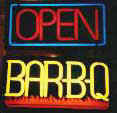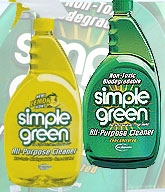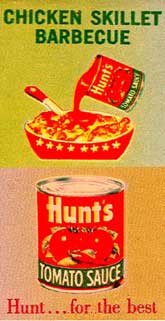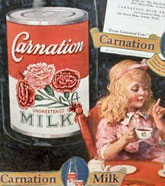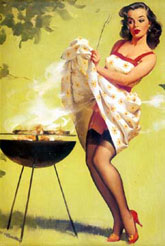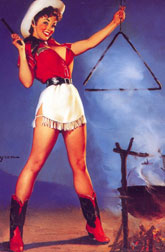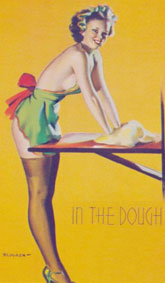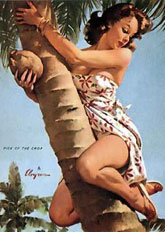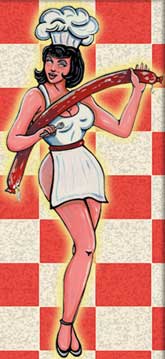Contact BBQbyDan
www.BBQDan.com
Search
KCBS BBQ Cook-Off Info
Recipes,
Smoking Meats
Recipes, Grilling
|
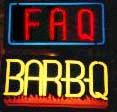 |
FAQ OF THE INTERNET BBQ LIST Version 2.0 Section 10.2.1 Beef Brisket, Jerky and Chopped Beef Sandwiches |
-------------------
[Does it make much difference if I use USDA Choice or Select beef for barbecuing?]
Dave Lineback--
I know of no good reason to make barbecue from "good" cuts of meats like beef steaks or pork tenderloins. They are great grilled. Barbecue, on the other hand, gets much of its flavor from the breakdown of connective tissues in "poor" cuts such as beef brisket and pork shoulders with slow cooking over long periods of time.
-------------------[Just what is a brisket, anyway?]
Editor--
The Epicurious dictionary defines a brisket as:
"Brisket--
[BRIHS-kiht] A cut of beef taken from the breast section under the first five ribs. Brisket is usually sold without the bone and is divided into two sections. The flat cut has minimal fat and is usually more expensive than the more flavorful point cut, which has more fat. Brisket requires long, slow cooking and is best when braised. Corned beef is made from brisket."
For Texas-Style barbecued brisket, we use the whole brisket, containing both the 'flat' and the 'point', untrimmed of fat, known in the industry as the 'Packer's cut'. The typical full brisket weighs in at 8-12 pounds and is about 12-20 inches long and about 12 inches wide. The 'point' is the thicker end and the 'flat' is the thinner end. The deckle end is the 'point' end.
--------------------[How do I barbecue a beef Brisket?]
Belly--
I think that beef brisket belongs to Texas like peanuts to Georgia and pulled pork to North Carolina. Did you know that until about forty years ago, brisket was considered a worthless cut of meat? Most folks would just discard it or grind into hamburger meat. But down in the hill country of Texas, ol' brother Wolf was buying all the brisket he could get to make his chili with. Then about 1950, two German brothers, who had a meat market, begin cooking barbecue in their market to use up leftover meat. So one of them got the idea to smoke a brisket as he was smoking sausage one weekend. So he left the brisket all weekend in his smokehouse. Then on Monday, as they were serving their barbeque--pork, sausage and chicken--he cut a slice off the brisket and put some on each lunch plate. Everyone began telling him how good and tender it was. So with that they began to cook beef brisket for barbecue. So Texas owes the two German meat market brothers from the hills of Texas for our Beef Brisket Barbecue.
Like lots of things, the briskets of today are so much improved over the time of the German brothers. The briskets of old were over half fat, but with the better cattle now, you get lots better beef brisket. But still the only way to make them good and tender is good slow cooking over good hardwood smoke. So here's the way this ol' Texan tries to cook a beef brisket.
Smoking A Beef Brisket
1 Pick a well-marbled brisket--one where most of the fat is down in the meat and not all fat on the outside--but you do need a layer of fat on the outside too. Fat inside the meat will help keep it moist, so you still need some fat both on inside and outside, but remember selecting a good brisket is half the technique of good barbecue. Get one in a Cryovac package.
2 Size of your brisket--a real good size is a brisket from 6 to 10 pounds. The size, big or small, will be more of a personal choice. Just remember slow cooking for 1 1/2 to 2 hours per pound is a pretty fair timetable for cooking a brisket at 225F. But first, ya got to season it!
3 Seasoning your brisket--there are as many ideas on the best way to season a brisket as there are brisket cooks. No two will do it the same and very few will do it the same way two times in a row. You can marinate, dry rub or both or sprinkle it with spices or do all three. I myself do a little of it all.
3A Marinate--maybe store bought marinate or maybe your own. I use a mix of Beer, Dr. Pepper, and Willingham's commercial marinade. Just cut a hole in the Cryovac package, pour in the marinade and seal the hole with some duct tape. I let the brisket marinate overnight in the refrigerator. Dry it off the next morning and let sit for about half an hour.
3B Dry Rub---I use a mix of Garlic powder, black pepper, salt, cumin, red pepper and a little brown sugar. Almost forgot the paprika; put some on as it gives the brisket a nice color. But there's lots of good dry rubs out there on the market. Try them. So after the brisket sits for 30 minutes, warming up, I give it a good rub with the dry rub mixture. Rub it in good, don't just sprinkle it on.
4 Fire--it don't make a big difference on what or how you're cooking as long as you have a good, low, long-time steady heat. It may be wood, electric or gas. I have for the last twenty-five years used a wood fire in everything from a barrel to wash pot to a high dollar smoker. I still say you can cook good barbeque in anything, as long as you watch your fire. What you want is a good steady low fire with a temperature between 200/225F at the meat level.
5 Smoke-cooking the brisket--Put the brisket on the grill fat side up. I have found that I do better with my brisket if I cook it about an hour per pound on a good low fire of hardwood and then wrap it in foil and put it in a picnic cooler or Styrofoam dry ice chest for up to eight hours (wrap it in some towels for more insulation, so it keeps warm longer). If I slow cook my brisket for 18/20 hours in the smoker my briskets are always too dry for me. But remember, any ol' boy can be like the blind dog and find a better way to do it. Good smoke will have a sweet flavor and that is what you want, not a bitter flavor. You will get a smoke ring of 1/32 to 1/2 inch most of the time. The presence or absence of a smoke ring don't make a big difference in the taste of your brisket but do make a better looking brisket. Different seasonings will make a difference in the size of your smoke ring.
6 Slicing and Presentation. Last but not to be overlooked, is the presentation of your brisket. I don't care if it just for your wife and kids or your mother-in-law or your boss or if you're in a million dollar cook-off, a brisket that is half bad, will come out extra good if it is sliced and presented just right. Always slice your brisket across the grain of the meat. This is very important, as it will make a more palatable and tender slice of meat. Remember, a good barbecued brisket don't need a sauce poured over it--serve it on the side.
7 Now, that's the way we do it up the Paluxy River in the hills of Texas. Talking about all this makes me want to go cook some barbecue. Beef that is.
--------------------[OK. I haven't got a 'real' barbecue smoker. Can I make good brisket on my electric water smoker?]
Jeff Lipsitt--
For sure. No question about it.
Rub the brisket the night before (try a commercial rub called Mr. Brown's). Wrap it up and sock it away in the refrigerator. Next morning, let the meat come to room temperature before putting it in the smoker (about an hour). I fill the water pan of my bullet smoker with HOT water, and bring the temperature up to 225F and throw chips/chunks on the heat source. When it starts to smoke, I put the brisket on a Pam-sprayed grill. Let the meat smoke for 1 1/2 hours (or more) per pound. Keep adding wood chips/chunks every hour or so when the smoke clears. During the last 2 hours, I put the meat in foil and bring up the sides to form a bowl. This catches the juices and the meat bathes in them. It's really simple--don't complicate things. In fact, some will say, just salt and pepper the brisket. The important thing is to smoke it LONG and SLOW. Try to keep the temperature in the cooker at 225F (at the level of the meat) or less--200F is preferable I think.
(Editor--the reason for allowing the meat to come to room temperature is two-fold. It will get up to cooking temperature faster--less fuel required, and putting a cold piece of meat in the smoker can cause creosote to condense on it if your fire is not well-managed.)
-------------------[Have you got any secrets on how to make really good barbecued brisket?]
Danny Gaulden--
(Editor--Danny says he's smoked over a hundred thousand briskets in the last 20 years. I tasted some and it was great--the best barbecued brisket I've ever had! The man knows his brisket.)
The first thing one needs to know is how to pick out a good brisket. For home smoking, one in the 8 to 10 pound range works well, and doesn't take as long to barbecue as an 11 to 12 pounder. Look for a brisket that has about 1/4 to 1/3 inch of fat across the top. This is generally called the "fat cap" by most barbecue folks. Don't buy a pre-trimmed piece, for it will not cook as tender, and will be dry. With the brisket lying down and the fat side up, try to pick one that is thick all the way across the flat. This can be hard to do sometimes, for most are thick on one side, and taper down to become fairly thin on the other side. Try to find one that has a more rounded point, rather than a pointed point. Briskets with rounded points tend to be more meaty in this area. Briskets come in two grades, "choice or select". Choice grading costs just a few cents per pound more than select, and generally has more marbling. Either will do well, but choice is usually a little better.
After you have chosen your brisket, generously apply a good rub on it, wrap it in clear wrap, and let it sit in the refrigerator overnight. This will allow the seasoning to work its way into the meat a bit.
The next day, as you are building your fire, bring meat out of the refrigerator and let it sit at room temperature for about 30 minutes. You do not HAVE to apply a second fancy rub at this point. If you don't have one, just use a little salt, pepper, and powdered garlic. You don't have to use any kind of a rub if that is your desire, but I prefer to use one.
After your fire has settled down to around 240-250F, put the brisket in the pit, fat side up and leave it like that the entire time if you're using a pit like my Big Bertha with a Ferris wheel rack system or a water smoker. Now if you're using an off-set firebox type pit, like a NBBD or a Klose, put the brisket on the rack fat side up and then turn it over and mop it every two hours so the bottom side doesn't get too much heat and dry out. While it's with the fat side up, the fat renders and penetrate in, over, and around the cooking meat. When brisket becomes fork tender in the flat, take it off the pit, let it cool for about 30 minutes, then slice and serve. Always check brisket for doneness in the FLAT, not the point. The point will generally become tender before the flat, and can deceive you. Continue to cook until the flat is tender. OK, a lot of folks on the BBQ List asked me what the internal temperature is when I take the brisket out of the pit after I figure they're done. So I measured a bunch of them with a meat thermometer and almost all of them were right at 188F.
If you're not ready to eat it as soon as it done, double wrap in foil, and set it in a non-drafty place or a small ice chest (no ice) until you are ready to serve it. Don't leave it for too many hours, or you can risk food poisoning. As long as the internal temperature of the meat stays between 140 to 160F, it is safe.
How many hours does one smoke a brisket? This argument will go on till the end of time, and is hard to answer, for there are so many variables. Two people that think they smoked their briskets exactly the same will most likely come out with two totally different finishing times. I like to smoke mine for about 1 to 1 1/4 hours per pound. That would put me at about 10 to 12 1/2 hours for a 10 lb. brisket. No longer. I peg 240-250F as constantly as possible. Sure, one will have some temperature ups and downs, but I keep it at that temperature fairly well. I don't go off and forget about the fire and I don't open my pit every 10 minutes to "take a peek". I choose a good piece of meat. All these things make a difference in how long the process will actually take. Another thing to take into consideration is the quality of the meat. All briskets are tough, but some are tougher than others. This will have an effect on the overall smoking time also. I have made a few boo-boos in my many years of smoking briskets, but not many. Ninety nine times out of a hundred, they are tender, juicy, smoky, and a piece of meat I am proud to serve to friends and customers.
==============Garry Howard and Ed Pawlowski--
Red Caldwell is a freelance cook and food writer based in San Marcos, Texas. He is a fifteen-year veteran of competitive cooking--chili cookoffs, barbecue, and mountain oysters. His cookbook, "Pit, Pot, and Skillet", has just been released by Corona Publishing of San Antonio, Texas.
Red's Barbecued Brisket
10 pound beef brisket
Most barbecue in Texas revolves around beef, and more specifically, brisket. When you select your brisket, choose only "packer trimmed" briskets in the ten to twelve pound category. The smaller briskets don't have enough fat to tenderize them, and the larger ones could have come off of a tough old range bull that no amount of cooking will ever tenderize. Avoid closely trimmed or "value packed" brisket pieces. The fat that was cut off to make 'em pretty is the very stuff that would have made them tender! All briskets have a fat cover on one side. Ignore this! Squeeze the thick end with both thumbs. When you've found the brisket with the smallest fat kernel, that's the one for you. Take it home and build your fire. While your fire is getting going--I build mine out of a mixture of mesquite and oak--rub your brisket with a dry "rub." (See Red's Dry Rub recipe below) Make sure that the meat is thoroughly coated. This helps seal the meat, and adds a flavorful crust.
Thoroughly coat all surfaces of the brisket with lemon juice, and rub in well. Sprinkle dry rub generously all over the brisket, rubbing in well. Make sure that the brisket is entirely covered.
When the wood has burned down, move the coals to one side of the smoker, place the meat away from the direct heat, fat side up (let gravity and nature do the basting), and close the smoker. Some people add a pan of water near the coals to provide added moisture, but I don't. Now, don't touch the meat for 12 hours. Just drink a few beers, cook a pot of beans, and tend your fire.
You'd like to hold the cooking temperature around 210F in the brisket cooking area. Since "helpers" usually show up at the first whiff of smoke, you probably ought to put some of your leftover rub on a couple of racks of pork ribs and toss them on the smoker, in the hotter end, and baste and turn 'em for four and five hours, just to keep the animals at bay. Meanwhile, see Red's Prize Winnin' Pintos recipe in the 'side orders' section of this FAQ to keep you busy.
Back at the smoker, after the twelve hours are completed, generously slather the brisket with a basting sauce (not a barbecue sauce), wrap it tightly in aluminum foil, and return to the smoker. (See Red's Basting Sauce recipe below). Close off all of the air supplies to the fire, and allow the meat to sit in the pit for three or four hours. This really tenderizes the meat.
Serve your brisket with beans, coleslaw, Jalapenos, onions, pickles, and plenty of bread. Cold beer or iced tea are the traditional beverages of choice.
You'll find that a ten-pound brisket will yield about 8-16 servings, depending on the individual brisket, and the size of the appetites of the guests.
Red's Dry Rub
Amount |
Measure | Ingredient | Preparation Method |
1 |
11 ounce can | chili powder | fine ground, light |
1 |
tablespoon | cayenne pepper | |
2 |
tablespoons | black pepper | |
4 |
tablespoons | garlic powder | |
1/2 |
cup | lemon juice |
Thoroughly coat all surfaces of the meat with lemon juice, and rub it in well. Combine all of the dry ingredients in a bowl, and sprinkle generously all over the meat, rubbing in well. Make sure that the meat is entirely covered. Store leftover rub in a tightly sealed container in the refrigerator.
Red's Basting Sauce
Amount |
Measure | Ingredient | Preparation Method |
2 |
tablespoons | chili powder | |
1/2 |
teaspoons | cayenne pepper | |
1 |
pound | butter | |
2 |
each | onions | peeled, thickly sliced |
5 |
cloves | garlic | peeled and crushed |
1 |
bunch | parsley sprigs | chopped |
1 |
bottle | beer | |
1 |
pint | vegetable oil | |
4 |
each | lemon | quartered |
1/4 |
cup | Worcestershire sauce | |
2 |
whole | bay leaves |
Melt the butter, add the onions and garlic, and sauté for 4 to 5 minutes to soften. Add the beer, squeeze in the lemon juice, and add the lemon rinds to the pot. When the foam subsides, add all of the remaining ingredients and bring to a boil. Reduce the heat to a medium low and simmer for 20 minutes. Keep baste warm, adding beer and oil as needed.
By the way, you'll notice that there are no tomatoes, ketchup, or sugar in this recipe. All of those things caramelize and burn quickly, giving the meat a black color and nasty taste.
--------------------
[OK, so now I've barbecued my brisket, how do I cut it?]
Jim McGrath--
The brisket you have contains two cuts of meat, the flat and the point. The grains of the two cuts run roughly perpendicular to each other. The flat starts at the thinner end and runs the whole length, dipping under the point, which is the thick fatty hump.
After the brisket is cooked, you will not be able to determine which direction the grain of the flat runs. Cut off a slice of meat at the end of the flat, perpendicular to the grain. This will give you a mark for cutting after the brisket is cooked. Always carve perpendicular to the grain.
Cook the brisket until the flat is fork tender. Trim off the point. Run a carving knife across the surface of the flat, dipping down under the point. There is a layer of fat separating the two cuts, so this is pretty easy to do by feel.
You can now trim the fat off the point and chop up the point meat, or you can return the point to your smoker and continue smoking it for 4 to 6 more hours to render the fat. This will produce the very intensely smoke-flavored "burnt ends".
==============
Danny Gaulden--
Before serving brisket, divide it into three pieces. Here's how you do it. Make sure you have a SHARP knife. Now, with lean side of brisket up, cut off the point (deckle end). The reason you want to do this with the lean side up is that it is much easier to see where the point and flat join. Now turn the brisket over with the fat side up and cut off the skirt, flap, whatever you want to call it. The reason for this is that the grain runs in a different direction than the flat and should be separated from it. With the skirt removed, trim the fat off of it, top and bottom and where it is connected to the flat. Don't be surprised if there is a lot of fat--another reason to separate these pieces. Now turn the skirt so that you are cutting against the grain, and make the slices at about a 30 to 45 degree angle. Cut slices off of the point also, going against the grain, and do the same to the flat. Mix the different cuts together, and serve.
--------------------
[What are "burnt ends" from a brisket?]
Jim McGrath and Danny Gaulden--
The burnt ends of a brisket come about two ways. As stated above, they can be made on purpose by returning the point to the smoker for another 4-6 hours and they can result from the thinner parts of the brisket's flat getting overcooked during the smoking process. The burnt ends are usually rather dry and very smoky tasting. These can be served thinly sliced with lots of barbecue sauce or chopped up and used in dishes like chili, stews and soups.
==============
Jeff Lipsitt--
I asked Jake, at Jake's Boss BBQ, certainly one of the best establishment Q'ers in New England, what was his definition of burnt ends.
Here's what he said:
"Traditionally, in Texas, the first cut on the flat and the point were not considered good sandwich or serving pieces. Those pieces were put away until quite a few briskets had produced enough 'first cuts' to chop and mix with barbecue sauce. One day a week, the menu would then feature 'burnt ends'. . . and the price was right!"
Then he went on to say: "Nowadays, because of the popularity of burnt ends, the whole brisket is used. Both the flat and point are roughly chopped and sizzled in a large pan over very high heat for a few minutes before adding barbecue sauce."
-------------------
[On my first try with smoking a brisket, the only one I could find was 14.5 lbs. What should I do, cut it in half and cook the point and the flat separately (the flat's about half the thickness of the point) or can I cook it whole and serve the flat earlier and continue cooking the point?]
Danny Gaulden--
Sorry to see you start out as a first timer with a 14 1/2 lb. brisket. An 8 pounder or so would have been much better, but I understand the situation. If you want to cut it in two, yes, you can separate the point from the flat. I see no reason to do this, for the point will take NO longer to barbecue than the flat. This is not the first time I have heard this inaccurate statement made--I don't know where it got started. Just because the point is thicker than the flat doesn't mean a thing. Why? The point has considerably more marbling than the flat, so even though it's thicker, it will be done when the flat is done. Remember, marbled parts of meat barbecue faster than leaner parts. As I have said before, start out at a lower heat, about 225F, and let it smoke slow for a hour or two, then kick it up to 240-250F. Trust me, this thing is going to be on the pit for so long, it will definitely have plenty of smoke flavor. Mop it with an oil baste mop every hour or so on both sides, especially the lean side. Turn it over every couple of hours, and let it cook on each side.
--------------------
[I over-smoked my first brisket--problems with fire-control. It's a little dry and too smoky in flavor. What can I do with it?]
Danny Gaulden--
Now, what to do with that too-smoky brisket. Chop it into small (I mean small) pieces, and marinade it overnight in your favorite barbecue sauce. Of course you know to do this in the refrigerator, not left out overnight. Make sure you use plenty of sauce when mixing the meat with it. Don't make it soupy, but don't make it dry! After letting it rest overnight, take the meat out of the refrigerator and warm it up in the microwave on low power. Microwave ovens work best here, for they won't burn the pot so to speak, like reheating in a pot can do with this kind of food on a fire. After warming, if the meat seems a little too dry, just add more of your sauce to it. Sometimes it can really soak up the sauce overnight while marinating. Now, just fill a bun with this stuff, and you'll have a great sandwich. Actually an over-smoked brisket works well with this recipe, for the smoke flavor is diminished by the marinating process.
-------------------
[I bought a brisket in a Cryovac package to barbecue this Sunday but I find I cannot do it for another week. I don't want to freeze it. How long can I safely keep the brisket in the unopened Cryovac package.
Kurt Lucas (Editor--Kurt is a restaurant owner in Salem OR)--
If the brisket was put into the Cryovac package at the packing plant it will last refrigerated for three to four weeks past the packing date as long as the seal isn't broken.
-------------------
[I bought my first brisket and need some help. It is only a 4 pounder. I got it at Sams in a Cryovac and it is called a "boneless beef brisket, flat half." Just what do I have here? How do I cook it?]
Danny Gaulden--
What you have is the flat part of a brisket with the point cut off. Whether it is half of a flat from a large brisket, or the whole flat of a small brisket doesn't really matter--you still have a flat. The fat layer covers one entire side of a whole brisket. In other words, it covers the flat and the point. The fat layer (cap) doesn't just cover the point. It covers the entire back side of the brisket--point and flat. You don't have a whole brisket, you have just the flat. It is normal for a packer trim, cryovac brisket to have a lean side, so don't worry about that. You have a lean side and a fat side. If it doesn't have a fat side, that means it has been "super trimmed" by the packing house or the local butcher, and you don't want that for barbecuing. The point is just what it says--the end of the brisket that makes a point, or rounded end. It is generally thicker than the flat. The flat is the wide, flat part of the brisket on the opposite end from the point. It generally tapers down in thickness, compared to the point. The flat is the toughest part of a brisket to cook, for it has the least marbling. Next time you buy a brisket, try to buy the whole darn thing--get a full brisket in a "Packer's cut or trim"! Some of the best eating comes from the point, and skirt underlying the flat. It cooks up more tender and usually juicer. Follow the FAQ on how to cook a brisket, and barbecue yours just like you have a whole one. Don't worry about it just being the flat. It will turn out fine. If it doesn't have a fat layer, use an oil-based mop every 45 minutes while it's cooking to keep it moist.
-------------------
[Anybody know what the yield is on a smoked brisket?]
Danny Gaulden--
A correctly cooked packer-cut brisket will lose 40% of its weight in the cooking process and the average person will trim off about 20% in fat, after cooking. With my briskets, I never expect to have over 4 lbs. of edible meat out of a 10 lb. average brisket. Sometimes we get a little more, sometimes, a little less.
--------------------
[Is beef jerky better if it's made in a smoker?]
Rick Thead--
I attended the school of hard knocks when it came to jerky on the smoker. I found that the key is to not try to completely dry the meat in the smoker. If you do, the meat will be so smoky that no one will be able to go near it.
I like to spread out the meat, and smoke at just below 150F, rotating the meat strips as they smoke. I smoke it for around 3 hours, and then finish it in a dehydrator. Go light on the smoke.
==============
Carey Starzinger--
Beef Jerky - Timpson
Amount |
Measure | Ingredient | Preparation Method |
5 |
pounds | beef roast | |
1/4 |
cup | soy sauce | |
1 |
tablespoon | Worcestershire sauce | |
1 |
teaspoon | garlic powder | |
1 |
teaspoon | onion powder | |
1 |
teaspoon | black pepper | cracked if possible |
| red pepper flakes | optional, to taste | ||
1 |
tablespoon | Liquid Smoke (optional) |
I make jerky by buying about 5 pounds of beef. Usually a roast. I then remove the fat. Cut thin strips of meat and place into marinade and let soak for about 24 hours. Remove from marinade and allow to air dry for at least one hour. If you have a meat smoker then omit the liquid smoke and smoke meat at a low temperature. Dry in dehydrator or oven set to lowest temperature setting, about 150F until dry.
==============
Wiley Mixon--
I've been making beef jerky in my American Harvest food dehydrator for about 5 years. Through several experiments I finally got a finished product that I was proud of. That happened when I joined this List. A few days ago someone suggested to smoke the meat strips about 3 hours then finish it up in the dehydrator. Man, that made all the difference in the world. I started with a 10 pound trimmed brisket and cut it into strips. Bought a bottle of Red Creek Jerky Marinade and added 1/2 cup sugar, and to taste, cayenne pepper, crushed red pepper, and coarse ground black pepper. I marinated the meat strips overnight in the refrigerator. I then smoked them for 3 hours at 200F with mesquite. Finished it up in the dehydrator for 6 hours at 145F. Excellent. Best jerky I've ever made.
==============
Dan M Sawyer
I would like to share a jerky making process that goes back a long way, before refrigerators, before electricity. To the best of my knowledge it has never been written down, just passed along from one old timer to the next - until now.
Dan's Smokehouse Jerky
The Meat:
Generally, the lean scraps from most venison (elk, deer, caribou, antelope and moose) work very good. Bear is greasy, as is pork. Buffalo is similar to beef and makes good jerky. The best cut of beef that will yield the most usable lean meat is the top round. If you like turkey, use large bone-in breasts and remove the bone. The meat should be reasonably aged, at least kept cool for a week or so after it's dressed out and skinned. It is important to trim as much fat off as possible, even if you have to cut it out or scrape it off. The fat will not take salt very well when the meat brines, it will become rancid and grow mold quickly. Cut the meat with the grain, into strips as big around as your thumb (3/4-1" square) and as long as possible.
The Brine:
This is a self-brining method and works in two stages, dehydration and rehydration. The ingredients needed are: kiln-dried medium salt. Most feed stores have 50# bags for about $3. which will make about eight thousand pounds of jerky. Medium salt is about the size of salt that comes on a pretzel. Molasses--I use Brer Rabbit light or Grandma's. Brer Rabbit comes in pint bottles and has a small top that you can pour a nice 'string' from. Grandma's comes in a large mouth bottle and it's best if you transfer it to some sort of a squeeze top ketchup or pancake syrup bottle (1 pint = about 20 lbs. of meat). Black Pepper, medium grind or coarse - your choice. If you like it hot, use red pepper flakes instead; if you don't like pepper, leave it out.
This brine process goes easier and more quickly if you have a few extra happy hands joining in - the kids, the wife and myself usually make it a project and when it's done everyone gets to pat each other on the back. Anyway, you will need a flat-bottomed non-corrosive container and lid--a Tupperware storage bin, a plastic bus tray or a stainless steam table pan will work well. The size depends on the amount of meat and the room in your refrigerator--the lids keep things out and are handy for stacking the containers. Salt the bottom of the pan evenly, making sure to get in the corners as well. This may not be as easy as it sounds. Put a few pounds of salt in a bowl, cup your fingers together and scoop out about a half a handful--not in your palm. Shake your hand back and forth across the top and about a foot above the top of the pan. As the salt starts to leave your hand, slowly open your fingers and let the salt run through evenly. Hand salting may require some practice. Practice salting the bottom of the pan until it becomes comfortable and the coverage is without gobs or streaks or voids. If this method becomes too frustrating, a shaker top jar works too--a mayonnaise jar with the metal lid poked full of holes by a 16 penny nail. The coverage amount should be between light coverage (barely covering) and full coverage (completely covering)--the only comparison I can think of is sugar on a pie crust or sugar on your cereal. You don't want it too salty, so one might consider their first batch of jerky experimental and take it from there.
String the molasses. Same kind of deal as the salt; hold the bottle about a foot above the pan, start moving it from side to side and pour. When the molasses starts running try to get a 'string' about the size of a pencil lead and let it crisscross the pan bottom over the salt. Once the strings are even in one direction, change directions (perpendicular) and string evenly across again. Don't forget the corners. When it's done, it will be an even grid about 1/2" square covering the pan bottom. Good luck and don't worry, 10-12 layers and you'll be able to sign your name with it. The pepper will vary as to individual taste. One note though, pepper almost doubles its intensity as it soaks and it is easy to overpower the finished product. I would recommend that a light dusting would be sufficient for most people (about the way you would pepper a baked potato). Red pepper flakes, even more so. Again, hold the pepper can about a foot above, and dust it evenly--good, you remembered the corners.
Layer the meat strips across the bottom of the pan one at a time. Starting on one side, place the strips next to each other without overlapping and with all of the strips running in the same direction. Work the meat across until the layer is complete, without voids. Pat the surface, edges and corners down smooth and flat. Salt, molasses and pepper the surface as was done to the bottom of the pan to start. The second layer of meat is done the same, but it is run perpendicular to the first layer. Pat smooth, salt, molasses and pepper. Run each additional layer perpendicular to the layer before it. Continue layering the meat until it reaches to a level about 2" from the top of the pan. The last layer, or partial layer, gets the salt, molasses and pepper treatment as well.
This brining method will cure the meat in two days. Place the pan(s) in the refrigerator, cover and let sit undisturbed for the first day (refrigeration is not necessary if prepared in a cool climate 35-45F). After about 24 hours the meat should be 'turned'. Dig your hands in the pan and separate all of the strips, turning it over several times to get the meat redistributed into a random order. Mash the meat back down into the brining juices (at this point the juice will be thin and watery), cover, and let sit for another day. I usually taste the juice at this point--if it tastes too salty the meat can be rinsed with water, but it will not be as good. If the salt is right it will have a slightly sweet, peppery flavor. During this next day the meat will soak up the brine juices and when the meat is removed before smoking, it will have a 'candied' texture--sticky and pliable. There should be very little, if any, brine solution left in the pan. The meat will have soaked up the brine and be somewhat swelled up, as compared to the first turning.
Smokehousing the meat: The smoking process will require a smokehouse or smoking unit that is capable of maintaining 80-90F. If there is a small volume, piping the smoke from an external source will provide a cooler smoke, and a hot plate or a few briquettes/lump charcoal could provide the heat source. In a medium size unit (refrigerator size), a cast iron frying pan with chips set on a hot plate will work--although it may be difficult to maintain a constant temperature. The more volume, the easier it is to control the temperature. I would recommend that a fire be built and maintained throughout the smoking process, which will take from 48 to 70 hours--depending upon the thickness of the meat.
The smokehouse that I use is medium-large (350) cu. ft. unit. It will maintain a good smoky 80-100F with 2-3 half gallon milk-jug-sized pieces of wood burning. Use seasoned, barkless wood of your choice. I use red alder, apple, plum, cherry, oak, pear and some of the best I've ever done was with some 75 year old grape stumps. Citrus works good too. Get the smokehouse going and rack or hang the meat while the temperature stabilizes. If you rack the meat, place it without the pieces touching each other--just enough room to run a finger between the strips. Stainless 3/16" rod sharpened on both ends works good for hanging--again, leave some space between the strips.
As you place the strips, run them through your thumb and index finger to squeegee off any excess brine. Before placing the racks or skewers into the smokehouse, coarse black pepper or additional red pepper flakes may be added for those who like lotsa zip. Load the smokehouse and leave the door cracked open for the first couple hours, or until the surface of the meat has dried to the touch. Close the doors, poke the fire and keep an eye on the temperature for a couple of days. Don't worry about the meat spoiling if the fire goes out. The meat is cured. It's said that the old timers used to make their jerky while they traveled. When they made camp at night they would hang the jerky over the campfire until dawn, when they broke camp they simply packed up the jerky and continued smoking the next night. This process takes about 4-5 days and is worth every minute. Probably the two most important items would be too much salt and too much heat. If you decide to try this method, I garr-own-tee you'll never find another piece of store bought jerky that even comes close.
--------------------
[How do you determine when the jerky is done?]
Dan--
The meat is cured before it goes into the smokehouse so, technically it's done at this point. The amount of smoke and how dry you might want it is of personal preference. The amount of moisture in the finished product will determine its shelf life. Some people like it softer and with a little less smoke, I'd call it kippered beef rather than jerky--there is still a percentage of moisture in the meat and it will sweat to the surface enabling mold growth--especially if it's kept in a plastic baggie or a closed container at room temperature. If you prefer it this way, put it in a mason jar and keep it in the freezer. I usually smoke the meat for three days, trying to keep the temperature as close to 90F as I can, at this point I'll start pulling out the thinner pieces that are dry and leave in the thicker pieces. My method of determining whether it's done isn't very scientific--I take my pocket knife and whittle a piece in half through the thickest part and look for meat fiber that is still somewhat reddish in color. Most of the time you can squeeze a piece, if it feels soft inside it needs more time, if it has no give to it, it's ready to remove. You can also over-do it, but the chances of this happening after tending a fire for three or four days is pretty slim--a prolonged temperature spike (120-150F for 1-2 hours) will cause the meat to cook on the inside and crust on the outside and it will stay that way--stopping the jerky process. Small, intermittent spikes or cooling below temperature doesn't really cause any problems.
--------------------
[I would like to try Dan's jerky but I don't have a smokehouse and I don't think that my NBBD will do the trick. Can you make Dan's Smokehouse Jerky in a regular barbecue smoker?]
Dave Crawford--
I made some of Dan's jerky a few months ago in my Hondo. No real problem keeping the temperature down. I just burned 1 or 2 lumps of mesquite charcoal at a time and kept putting small chunks of flavor wood on top of the coals. I smoked it in the Hondo for about 32 hours, then moved it inside to the oven (set to low) to finish drying it. The jerky in the hotter end of the smoker dried and finished a bit before that in the other end. All was excellent.
10.2.3 Barbecued chopped beef sandwiches
--------------------
[I have dentures and eating meat is difficult for me. Any suggestions?]
Danny Gaulden--
The marinated smoked brisket we sell in my store is called "chopped beef". It's a big seller. We sell about 40 to 50 pounds of it a day. I love it. What's neat about it is this: not only do all age groups like it, a lot of folks with dentures really like it. It's very flavorful, smoky, bold, and easy to eat. It definitely tastes like and is 'Real Pit BBQ', it's also marinated. So if one has dentures, I think a good chopped beef sandwich is their cup of tea. However the sauce that you use for a marinade is critical. It shouldn't be too strong, too thick, or over-powering. And for sure, not induced with liquid smoke. The sauce should compliment the smoked meat, and help bring out the natural flavor of it. Sauce should be composed of cider vinegar, mustard, oil, sugar, spices, and a little tomato product--not too heavy on the tomato. It should have a tangy, semi-sweet taste. (Sorry, I can't give you my secret recipe). The meat should be marinated while it's warm, and overnight for best flavor, but works OK if it's just marinated for a couple of hours. The meat should be chopped or pulled into very small pieces before it is marinated. Chop all of the meat--outside and inside. You must include the outside bark for a great flavor. Got this recipe from a real ol' time pit-master that still runs his own Q joint in Louisiana after 40 years. I grew up eating his barbecue. Hope this post and recipe gives you something to have fun with, and most of all, enjoy preparing and eating barbecue!
==============
William Ackerman--
I made some really great chopped beef sandwiches. I smoked a brisket by roughly following Belly's marinade advice (cut a slit in the Cryovac package, poured in Willingham's marinade, Balsamic vinegar, and Dr. Pepper, covered slit with duct tape. Let it marinade for 24 hours. Dried and rubbed with Willingham W'HAM rub.)
I smoked the brisket for 9 hours (1 hour per pound) at 225-250F using oak, cherry, and hickory. Cooked fat side up for first 5 hours, fat side down for the next 4 hours. Every so often I sprayed with Garlic Mist (oil with garlic in an aerosol can - great stuff!). The internal temperature when I removed the brisket was 165F.
I wrapped the meat in foil and placed it in a dry ice chest for 4 hours. Internal temperature when removed the brisket from chest was 146F. While still warm, I cut the meat into little pieces and marinated it over night in a sauce.
Ackerman's Chopped Beef Sandwich Marinating Sauce
Amount |
Measure | Ingredient | Preparation Method |
1/4 |
cup | Cattleman's Original (no smoke | |
1/2 |
cup | cider vinegar | |
1/4 |
cup | French's mustard | |
1 1/2 |
cups | raw sugar (turbinado) | |
2 |
tablespoons | garlic oil | |
1 |
pinch | each salt | |
1 |
pinch | black pepper | freshly ground |
The sauce is tangy and semi-sweet.
I heat up the chopped brisket in a double boiler and serve it on lightly toasted onion rolls.
You can download all the recipes in this FAQ ![]() Click here
Click here
Go to the next section
Return to the Table of Contents
Return to the BBQ FAQ Home Page
Comments or Suggestions
BBQ FAQ Ver 1.0, 2.0 ©1997, 1998 William W. Wight. All rights reserved.

